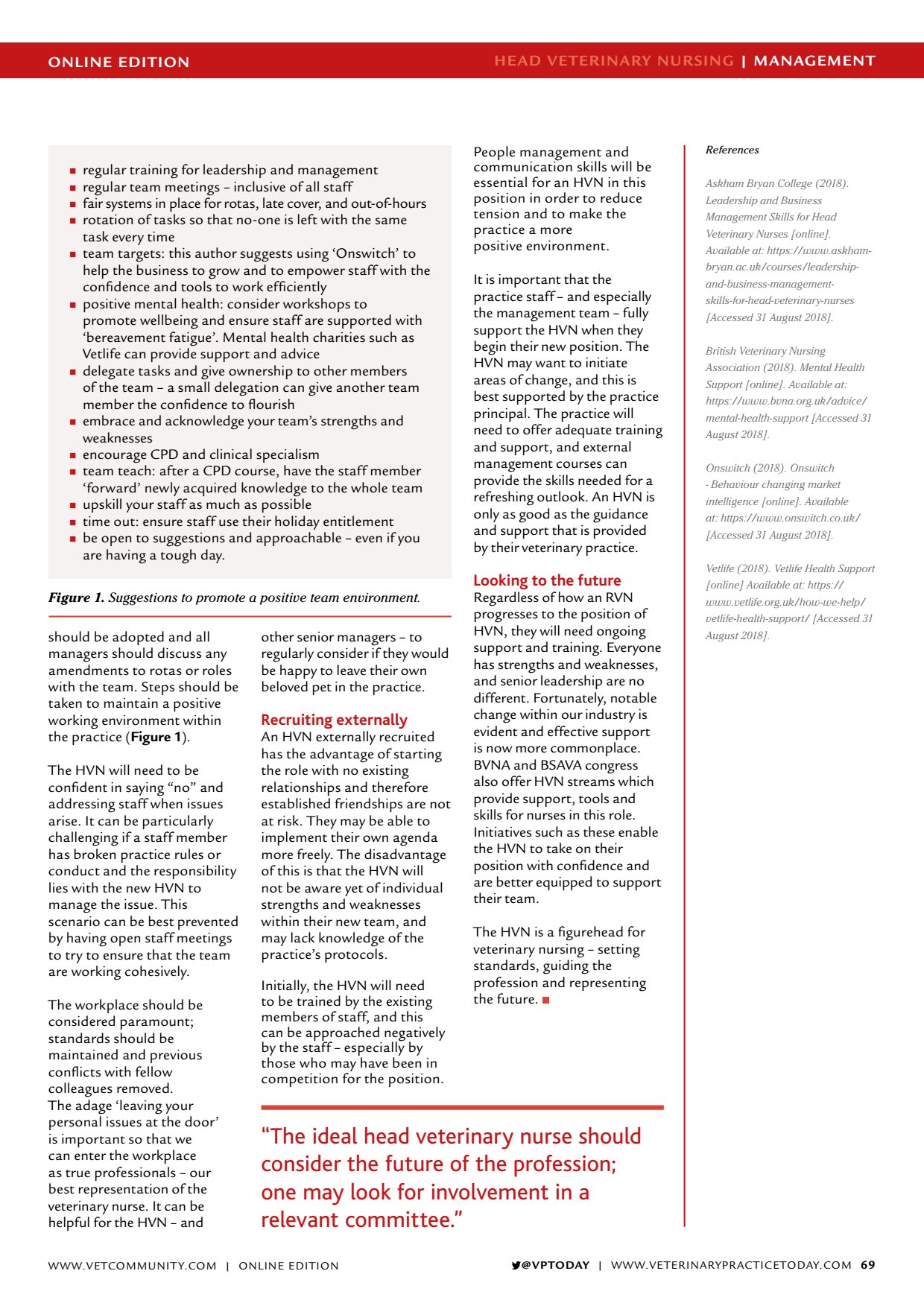Recruiting externally Looking
ONLINE EDITION HEAD VETERINARY NURSING | MANAGEMENT VPTODAY | WWW.VETERINARYPRACTICETODAY.COM 69 regular training for leadership and management regular team meetings inclusive of all staff fair systems in place for rotas, late cover, and out-of-hours rotation of tasks so that no-one is left with the same task every time team targets: this author suggests using Onswitch to help the business to grow and to empower staff with the confidence and tools to work efficiently positive mental health: consider workshops to promote wellbeing and ensure staff are supported with bereavement fatigue. Mental health charities such as Vetlife can provide support and advice delegate tasks and give ownership to other members of the team a small delegation can give another team member the confidence to flourish embrace and acknowledge your teams strengths and weaknesses encourage CPD and clinical specialism team teach: after a CPD course, have the staff member forward newly acquired knowledge to the whole team upskill your staff as much as possible time out: ensure staff use their holiday entitlement be open to suggestions and approachable even if you are having a tough day. should be adopted and all managers should discuss any amendments to rotas or roles with the team. Steps should be taken to maintain a positive working environment within the practice ( Figure 1 ). The HVN will need to be confident in saying no and addressing staff when issues arise. It can be particularly challenging if a staff member has broken practice rules or conduct and the responsibility lies with the new HVN to manage the issue. This scenario can be best prevented by having open staff meetings to try to ensure that the team are working cohesively. The workplace should be considered paramount; standards should be maintained and previous conflicts with fellow colleagues removed. The adage leaving your personal issues at the door is important so that we can enter the workplace as true professionals our best representation of the veterinary nurse. It can be helpful for the HVN and other senior managers to regularly consider if they would be happy to leave their own beloved pet in the practice. Recruiting externally An HVN externally recruited has the advantage of starting the role with no existing relationships and therefore established friendships are not at risk. They may be able to implement their own agenda more freely. The disadvantage of this is that the HVN will not be aware yet of individual strengths and weaknesses within their new team, and may lack knowledge of the practices protocols. Initially, the HVN will need to be trained by the existing members of staff, and this can be approached negatively by the staff especially by those who may have been in competition for the position. People management and communication skills will be essential for an HVN in this position in order to reduce tension and to make the practice a more positive environment. It is important that the practice staff and especially the management team fully support the HVN when they begin their new position. The HVN may want to initiate areas of change, and this is best supported by the practice principal. The practice will need to offer adequate training and support, and external management courses can provide the skills needed for a refreshing outlook. An HVN is only as good as the guidance and support that is provided by their veterinary practice. Looking to the future Regardless of how an RVN progresses to the position of HVN, they will need ongoing support and training. Everyone has strengths and weaknesses, and senior leadership are no different. Fortunately, notable change within our industry is evident and effective support is now more commonplace. BVNA and BSAVA congress also offer HVN streams which provide support, tools and skills for nurses in this role. Initiatives such as these enable the HVN to take on their position with confidence and are better equipped to support their team. The HVN is a figurehead for veterinary nursing setting standards, guiding the profession and representing the future. Figure 1. Suggestions to promote a positive team environment. The ideal head veterinary nurse should consider the future of the profession; one may look for involvement in a relevant committee. References Askham Bryan College (2018). Leadership and Business Management Skills for Head Veterinary Nurses [online]. Available at: https://www.askham- bryan.ac.uk/courses/leadership- and-business-management- skills-for-head-veterinary-nurses [Accessed 31 August 2018]. British Veterinary Nursing Association (2018). Mental Health Support [online]. Available at: https://www.bvna.org.uk/advice/ mental-health-support [Accessed 31 August 2018]. Onswitch (2018). Onswitch - Behaviour changing market intelligence [online]. Available at: https://www.onswitch.co.uk/ [Accessed 31 August 2018]. Vetlife (2018). Vetlife Health Support [online] Available at: https:// www.vetlife.org.uk/how-we-help/ vetlife-health-support/ [Accessed 31 August 2018]. WWW.VETCOMMUNIT Y.COM | ONLINE EDITION
